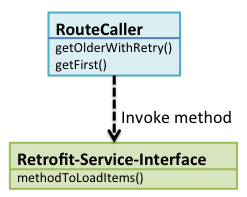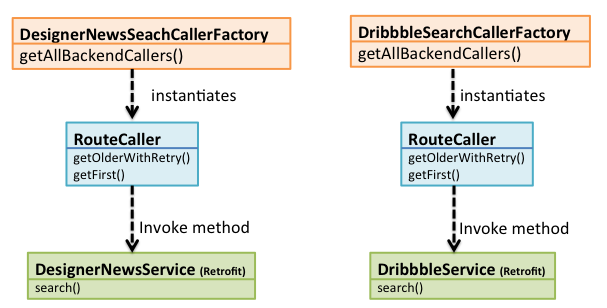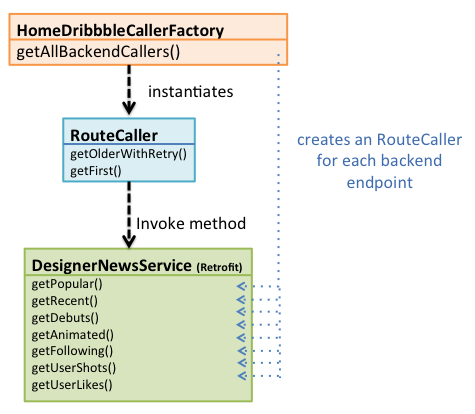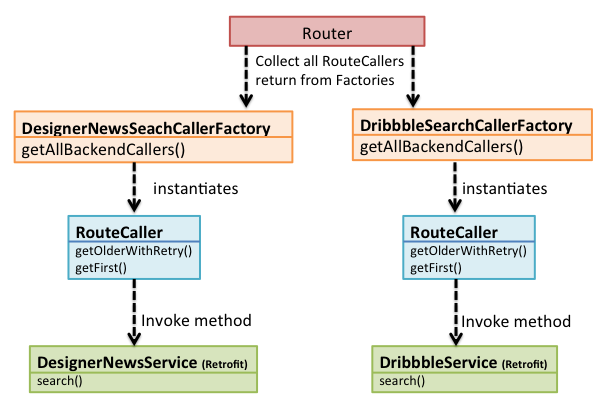Nick Butcher has open sourced on github an awesome app called Plaid. The app is pretty cool and has an outstanding UI / UX. Whenever source code of such awesome apps are available developers start to copy code and best practice tips from it. So I did the same and decided to dive into the code of Plaid. As always, you will find some parts of the code that you think could be implemented or be written in another way. So instead of just talking about code I have decided to spend some of my spare time to refactor some parts of Plaid’s source code. This blog post is the first part of a series of 3 posts of how I would refactor the Plaid app and to share my thoughts.
Preface: I started the refactoring with the strong belief that I can refactor the whole app. Surprisingly (ironic), it turns out that I was a very naive man. I simply have underestimated the complexity of the app and the number of features. I discovered some features only after having spent some hours with Nick Buchter’s code, which were not “visible” to me just by using the app. In short: I realized that I don’t have the time to put all my thoughts into action. Hence my “refactoring” is focused on the apps “homepage” and the “search screen”, which I have refactored mostly. Nevertheless, I want discuss (in theory) some more things that could be refactored, but I didn’t because of time constraints. My refactored code can be found on github as well.
First look
The overall user experience and user interface is pretty awesome. I can’t describe it better than this tweet:
If you think Material Design is all about cards and shadows, take a look at Plaid and think again https://t.co/IYO3QnxkFu
— Luis G. Valle (@lgvalle) November 3, 2015
It’s a joy to use the app. The UI / UX is truly an inspiration for every developer and designer. However, after playing around a little bit more with the app I faced some visual bugs:
-
Displaying a loading indicator and error message at the same time:
-
In the app you can apply some “filters” or in other words: You can specify which “sources” of Dribbble, Designer News and Product Hunt you want to display. If you deselect such sources while loading an http request is currently running you can run into the state where the app displays items, but shouldn’t since no sources are selected:
-
Also the app doesn’t handle screen orientation changes properly. It simply rebuilds the entire screen so that after each orientation change you see the loading indicator again, and re-execute the http calls:
Typically such “issues” are a first indicator for spaghetti code and a moderate software architecture. So let’s take a look under the hood and check out the source code and the components for displaying a list of items: The HomeActivity (about 750 lines of code) handles the visibility of UI elements like displaying the RecylcerView or the ProgressBar. This activity also decides when to display the Source-Filters-Drawer (on the right side). Furthermore, in it’s onActivityResults() it does a lot of things inclusive posting new post to designers news. Last but not least it also loads the data for the selected filters by using a DataManager. You see, the HomeActivity has many responsibilities, probably too many. The DataManager basically uses a combination of Retrofit and AsyncTasks to execute http calls to load the data. The tricky thing here is pagination. Whenever the end of the RecyclerView has been reached, more (older) items are loaded. DataManager uses internally a HashMap to track the current page each source (backend endpoint like “Dribbble Popular” or “Dribbble Recent” or “Designer News Popular”) is currently displaying. The items are displayed in a RecyclerView by using FeedAdapter. The SearchActivity is working quite similar as HomeActivity: It uses a DataManager and a FeedAdapter as well.
The architecture
From my point of view there is no clear architecture in the current implementation. HomeActivity is some kind of god object that manages many things. Another “issue” is that HomeActivity changes the UI state by calling the same (internal) methods from different other methods and different events, i.e. the method checkEmptyState() get’s called from 4 different point’s in HomeActivity source code.
We will refactor that by applying a Model-View-Presenter with a passive view. The passive view will only be display that things that the presenter tells to do. I’m a fan of MVP with a passive view. People ask me from time to time why I recommend to use passive view and not supervising controller or other MVP derivations. Well, if you use MVP without passive view, you basically are splitting the spaghetti code formerly sitting in the view to half presenter and half view.
HomeActivity in MVP
So with MVP + passive view we split the responsibilities into two classes: HomeActivity implements HomeView is now considered as View (passive view) and implements this interface:
interface HomeView : MvpView {
fun showLoading()
fun showContent()
fun showError()
fun showLoadingMore(showing: Boolean)
fun showLoadingMoreError(t: Throwable)
fun addOlderItems(items: List<PlaidItem>)
}
From now on the job of HomeActivity is to manage the UI elements (visibility, coordinate animations, etc.) but only after the presenter told to do so. So the state of the View is managed by the HomePresenter. The HomePresenter looks like this:
class HomePresenter(private val itemsLoader: ItemsLoader<List<PlaidItem>>) : RxPresenter<HomeView, List<PlaidItem>>() {
fun loadItems() {
view?.showLoading()
subscribe(
itemsLoader.firstPage(),
{ // onError
view?.showError()
},
{ // onNext
view?.addOlderItems(it)
view?.showContent()
}
)
}
fun loadMore() {
view?.showLoadingMore(true)
subscribe(
itemsLoader.olderPages(),
{ // onError
view?.showLoadingMoreError(it)
},
{ // onNext
view.addOlderItems(it)
view.showLoadingMore(false)
}
)
}
}
If you haven’t noticed yet: We use kotlin as programming language, mainly because I like the language and to have the chance to see how development with kotlin works in a “real world” application. Thanks to the kotlin’s interoperability I can easily reuse Nick Butcher’s java source code, mainly for UI / View things.
For implementing MVP we use Mosby, a MVP library, which also allows us to keep the presenters during screen orientation changes. So we don’t have to restart with loading data and we don’t see the ProgressBar after screen orientation changes. Mosby allows us to keep the views state as before the orientation change.
Last but not least I have decided to use RxJava for my “Model” (hence the subscribe() method in the presenter). So the ItemsLoader is my refactored and reactive version Nick Butcher’s DataManager. I will explain the ItemsLoader in a minute.
SearchActivity in MVP
As already said, running a search is very similar to HomeActivity. It displays a list (grid) of items and adds pagination to load more items when the end of the RecyclerView has been reached. So applying MVP to SearchActivity is pretty the same as shown before:
public interface SearchView extends MvpView {
void showLoading();
void showContent();
void showError(Throwable t);
void showLoadingMore(boolean showing);
void showLoadingMoreError(Throwable t);
void addOlderItems(List<PlaidItem> items);
void showSearchNotStarted();
}
class SearchPresenter(private val itemsLoaderFactory: SearchItemsLoaderFactory) : RxPresenter<SearchView, List<PlaidItem>>() {
private var itemsLoader: ItemsLoader<List<PlaidItem>>? = null
fun search(query: String) {
// Create items loader for the given query string
itemsLoader = itemsLoaderFactory.create(query)
view?.showLoading()
subscribe(itemsLoader!!.firstPage(), { // Error handling
view?.showError(it)
}, { // onNext
view?.addOlderItems(it)
}, {
view?.showContent()
})
}
fun searchMore(query: String) {
view?.showLoadingMore(true)
subscribe(itemsLoader!!.olderPages(), { // Error handling
view?.showLoadingMore(false)
view?.showLoadingMoreError(it)
}, { // onNext
view?.addOlderItems(it)
}, { // onComplete
view?.showLoadingMore(false)
})
}
fun clearSearch() {
// Unsubscribe any previous search subscriptions
unsubscribe()
view.showSearchNotStarted()
}
}
The only different compared to HomePresenter is that SearchPresenter takes a SearchItemsLoaderFactory as constructor parameter and creates a ItemsLoader dynamically for each search query. We will see how this works in a minute.
ItemsLoader and Pagination
So far we have covered View and Presenter. Now lets discuss how we could refactor the “Model” or use case / interactor if you want to compare it with uncle Bob’s clean architecture.
Before we start: There is a class called PlaidItem (holds properties like title and image url). This class is the base class to represent a single item:
- Shot extends PlaidItem for an item loaded from Dribbble
- Story extends PlaidItem for an item loaded from Designer News
- Post extends PlaidItem for an item loaded from Product Hunt
So now let’s discuss how we rewrite DataManager more efficiently by using RxJava. I don’t use RxJava because I think it’s cool and all the cool kids have to use RxJava nowadays. You will (hopefully) see the benefits of using RxJava afterwards (especially in the second part of this blog post series).
The hard part of loading items is that we support pagination and loading items from different backends. So let’s build the ItemsLoader from “bottom-up”. At the “bottom” we will find a Retrofit interface for executing the http call. Right now in Plaid you can search DesignerNews and Dribbble. The pagination problem: Dribbble loads 100 items and requires such a call loadItems(0, 100) and the next page will be loadItems(100, 200) while DesignerNews increments his page by 1 loadItems(0, 1) and next page will be loadItems(1, 2). We need a common API for both. Since we use kotlin we can pass “method references” (function poitners) or lambdas. So what we need is a component that takes such a function, executes this function and returns an Observable where we get the result of the actual http call. So basically we need something like this: backendMethodToCall: (Int, Int) -> Observable<T>, where the first int parameter is the page offset, the second int parameter the limit (how many items should be loaded per page) and T is the generic type of the result (in fact we are always loading List<PlaidItem>).
We call that component RouteCaller:
class RouteCaller<T>(private val startPage: Int = 0,
private val itemsPerPage: Int,
private val backendMethodToCall: (Int, Int) -> Observable<T>) {
/**
* Offset for loading more
*/
private val olderPageOffset = AtomicInteger(startPage)
/**
* A queue that is used to retry "older"
* pages if they have failed before continue with even more older
*/
private val olderFailedButRetryLater: Queue<Int> = LinkedBlockingQueue<Int>()
/**
* Get an observable to load older data from backend.
*/
fun getOlderWithRetry(): Observable<T> {
val pageOffset = if (
olderFailedButRetryLater.isEmpty()) {
olderPageOffset.addAndGet(itemsPerPage)
} else {
olderFailedButRetryLater.poll()
}
return backendMethodToCall(pageOffset, itemsPerPage)
.doOnError {
olderFailedButRetryLater.add(pageOffset)
}
}
/**
* Get an observable to load the newest data from backend.
* This method should be invoked on pull to refresh
*/
fun getFirst(): Observable<T> {
return backendMethodToCall(startPage, itemsPerPage)
}
}
RouteCaller takes such a method (Int, Int) -> Observable<T> as constructor parameter and will call this method internally with the correct parameters:
- getFirst() loads the first page
- getOlderWithRetry(): This method is responsible to load older items. We keep track of the current page in the field olderPageOffset and we will increment this one when we start loading more items (or in other words: load an older page). Additionally, we use .doOnError() to retry to load the failed page when loading the next page.
So the responsibility of RouteCaller is to fill out the parameters (page offset and page limit) needed for the real http backend endpoint call. So what we have is something like this:

For executing a search we have two backends to query DesignerNewsService and DribbleService. That means that we have two RouteCallers (one for each backend search method to invoke):

The next question is: How do we instantiate a RouteCaller? We define a RouteCallerFactory for each backend, which basically offers a method getAllBackendCallers() where we get an Observable List<RouteCaller> we should execute to load items.
interface RouteCallerFactory<T> {
/**
* Get all available backend route callers
*/
fun getAllBackendCallers(): Observable<List<RouteCaller<T>>>
}
For executing a search we have DesignerNewsSearchCallerFactory and DribbbleSearchCallerFactory: The DesignerNewsSearchCallerFactory looks like this:
class DesignerNewsSearchCallerFactory(private val searchQuery: String, private val backend: DesignerNewsService) : RouteCallerFactory<List<PlaidItem>> {
val extractPlaidItemsFromStory = fun(story: StoriesResponse): List<PlaidItem> {
return story.stories
}
// The method to execute from RouteCaller
val searchCall = fun(pageOffset: Int, itemsPerPage: Int): Observable<List<PlaidItem>> {
return backend.search(searchQuery, pageOffset).map(extractPlaidItemsFromStory)
}
// Create a list with one single RouteCaller() with "searchCall" as method reference
private val callers = arrayListOf(RouteCaller(0, 100, searchCall))
override fun getAllBackendCallers(): Observable<List<RouteCaller<List<PlaidItem>>>> {
return Observable.just(callers)
}
}
At first glance DesignerNewsSearchCallerFactory looks a little bit strange if you are new to kotlin because we don’t use lambdas but instead we create a property searchCall which actually is a function (Int, Int) -> Observable<List<PlaidItem>>.
The reason why we do this is testability: Recently I have watched the fireside chat of Android Dev Summit 2015 where the guys from the Android Team has been asked when they will add Java 8 support. Then Reto Meier, from the Android Team, answered that many developers are mainly interessted in lambdas and asked the audience if they could raise the hand if they want lambdas for android development: Almost the whole audience has raised the hand. I think that there is a general misunderstanding with lambdas: the real power of programming language that offer lambdas are not lambdas itself, is higher order functions and the ability to passing method references. Lambdas are just kind of anonymous functions. Actually, lambdas are not testable, because they are hardcoded. For example if I would have implemented something like this:
RouteCaller(0, 100, { pageOffset, limit -> backend.search(searchQuery, pageOffset) })
How do we write a unit test for that lambda? It’s not possible to write a unit test for that lambda since the lambda is “hardcoded”, whereas if we pass a function reference we can easily unit test a function. In java 8 we can pass a method reference by writing this::searchCall. Unfortunately, this syntax is not supported yet in kotlin (right now :: only supports static methods). Therefore this “workaround” by defining a function as property. More about my experience with kotlin in the last part of this series of blog post.
All right, so for executing a Search we have something like this:

Please note that for the search getAllBackendCallers() returns a list containing just one RouteCaller, but the idea is that a RouteCallerFactory creates all RouteCallers to all available endpoints of a certain backend. As we will see later, the HomeDribbbleCallerFactory returns a list of RouteCallers for each Dribbble endpoint to load items like popular items, recent, animated etc. So we have something like that:

Next we introduce a Router which is responsible to combine all RouteCaller from different RouteCallerFactories to one single Observable list:
class Router<T>(private val routeFactories: List<RouteCallerFactory<T>>) {
fun getAllRoutes(): Observable<List<RouteCaller<T>>> {
val callers = ArrayList<Observable<List<RouteCaller<T>>>>()
routeFactories.forEach {
callers.add(it.getAllBackendCallers())
}
return Observable.combineLatest(callers, { calls ->
val items = ArrayList<RouteCaller<T>>(calls.size)
calls.forEach {
items.addAll(it as List<RouteCaller<T>>)
}
items // return items
})
}
}
As you see the Router takes a list of RouteCallerFactory, in other words: a Router can be configured via constructor. So to complete the “routing picture”:

Ok, so far we have covered the “routing part”. So at the end the Router offers an Observable<List<RouteCaller<T>>>. But when do we finally load items to display them in the RecyclerView. This is the responsibility of ItemsLoader. As the name already suggests this component loads items:
class ItemsLoader<T>(protected val router: Router<T>) {
fun firstPage(): Observable<T> {
return FirstPage<T>(router.getAllRoutes()).asObservable()
}
fun olderPages(): Observable<T> {
return OlderPage<T>(router.getAllRoutes()).asObservable()
}
}
The ItemsLoader takes a Router as constructor parameter and offers two methods:
- firstPage(): Returns an Observable representing the first page.
- olderPages(): Returns an Observable to load older pages.
A Page represents a page of items displayed in the RecyclerView. If we scroll to the end of the RecyclerView we load the next page containing older items. Let’s have a look at the FirstPage extends Page and OlderPage extends Page classes:
abstract class Page<T>(val routeCalls: Observable<List<RouteCaller<T>>>) {
private var failed = AtomicInteger()
private var backendCallsCount: Int = 0
/**
* Return an observable for this page
*/
fun asObservable(): Observable<T?> {
return routeCalls.flatMap { routeCalls ->
backendCallsCount = routeCalls.size
val observables = arrayListOf<Observable<T>>()
routeCalls.forEach { call ->
val observable = getRouteCall(call).onErrorResumeNext { error ->
// Suppress errors as long as not all fail
error.printStackTrace()
val fails = failed.incrementAndGet()
if (fails == backendCallsCount) {
Observable.error(error) // All failed so emmit error
} else {
Observable.empty() // Not all failed, so ignore this error and emit nothing
}
}
observables.add(observable);
}
// return the created Observable
Observable.merge(observables)
}
}
protected abstract fun getRouteCall(caller: RouteCaller<T>): Observable<T>
}
class FirstPage<T>(routeCalls: Observable<List<RouteCaller<T>>>) : Page<T>(routeCalls) {
override fun getRouteCall(caller: RouteCaller<T>): Observable<T> {
return caller.getFirst();
}
}
class OlderPage<T>(routeCalls: Observable<List<RouteCaller<T>>>) : Page<T>(routeCalls) {
override fun getRouteCall(caller: RouteCaller<T>): Observable<T> {
return caller.getOlderWithRetry();
}
}
Page is responsible for finally executing the http call by invoking RouteCaller’s method. We also don’t want that one entire page fails just because one backend call has fails. Therefore we use onErrorResumeNext() to “intercept” errors and only return an error if all http calls have failed.
Then the Presenter subscribes to the “page” observable via ItemsLoader.
Dependency Injection
You might have already noticed that almost all components described so far takes other components as constructor parameter. This is by design. Now, we use Dagger (I used Dagger1) to compose such element as needed:
@Module(
injects = {
HomePresenter.class
},
addsTo = ApplicationModule.class // contains Retrofit interfaces
)
public class HomeModule {
@Provides @Singleton HomePresenter provideSearchPresenter(SourceDao sourceDao,
DribbbleService dribbbleBackend,
DesignerNewsService designerNewsBackend,
ProductHuntService productHuntBackend ) {
// Create the router
List<RouteCallerFactory<List<? extends PlaidItem>>> routeCallerFactories = new ArrayList<>(3);
routeCallerFactories.add(new HomeDribbbleCallerFactory(dribbbleBackend, sourceDao));
routeCallerFactories.add(new HomeDesingerNewsCallerFactory(designerNewsBackend, sourceDao));
routeCallerFactories.add(new HomeProductHuntCallerFactory(productHuntBackend, sourceDao));
Router<List<? extends PlaidItem>> router = new Router<>(routeCallerFactories);
ItemsLoader<List<? extends PlaidItem>> itemsLoader = new ItemsLoader<>(router);
return new HomePresenterImpl(itemsLoader);
}
}
As you see, we can use Dagger to configure our Router and ItemsLoader. For the SearchPresenter we configure an ItemsLoader and Router in SearchModule. The advantage is that if we one day would like to add another “source”, like reddit, to display items from reddit, the only thing we have to do is to define a RedditService (Retrofit), a RedditCallerFactoy and add this CallerFactory to the Router. We can do that in the concrete dagger module without having to touch another already existing component’s source code (Open-Closed principle). In other words: we have built a “plugin system” configureable through dependency injection.
You might have noticed the SourceDao class in the code shown above. We will talk about that in the second part of this blog series when we are going “truly reactive”.
Conclusion of Part 1
This is the first part of a series of blog post. In this first part we have built the fundament by applying Model-View-Presenter and have refactored the way how the app loads data from the backend endpoints. The main idea is to cut this huge and complex task down into several smaller and reusable components like ItemsLoader, Page, Router and RouteCaller which follows more the SOLID principle as Nick Butcher’s DataManager implementation.
As always, there are better ways to implement such an app. Especially, the ItemsLoader can be done entirely different. My first intention was to create an unlimited Observable for load older pages by using RxJava’s switchOnNext() or merge operators as described by Matthias Käppler, but I came to the conclusion that some things regarding UI and error handling are slightly easier to implement if I can split the single observable into two observables (one for first page, one for older page).
As always, feedback and suggestions are very welcome!
In the next (second) part of this series of blog posts about refactoring the Plaid app we will go “truly reactive” by using the real power of RxJava. Stay tuned.
This is a post in the Refactoring Plaid App series.
Other posts in this series: